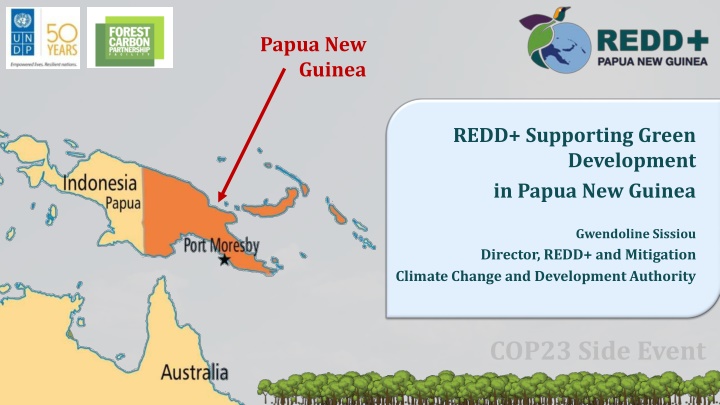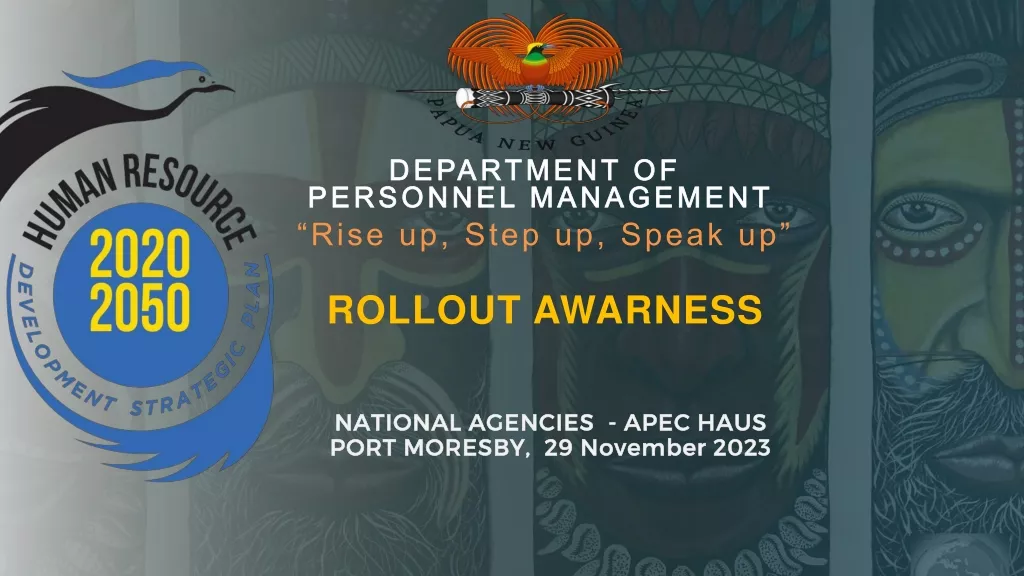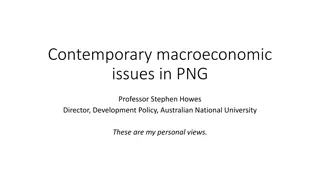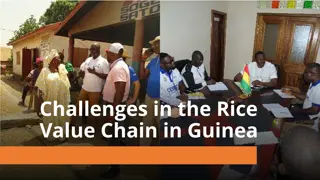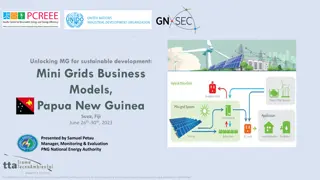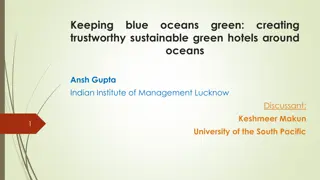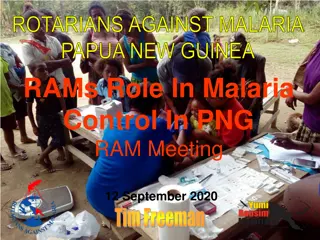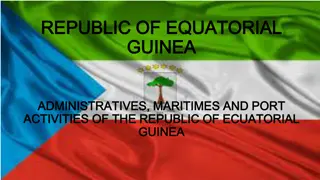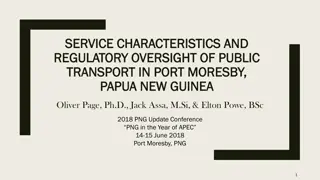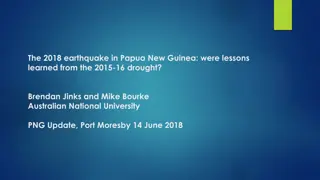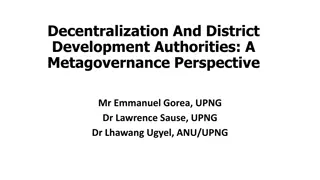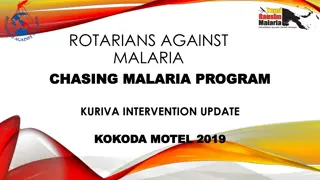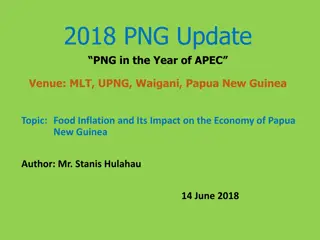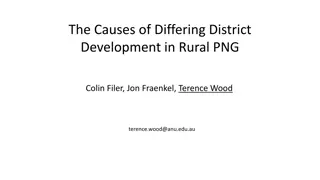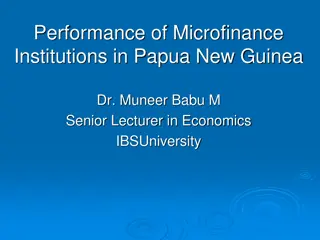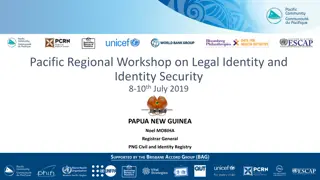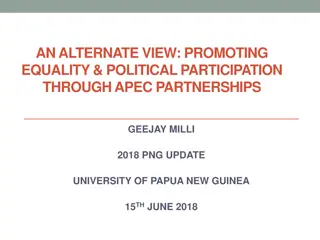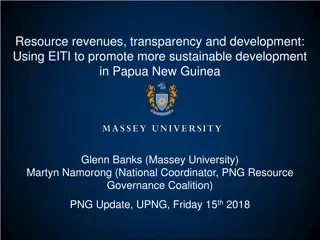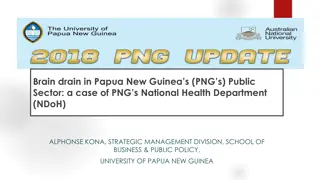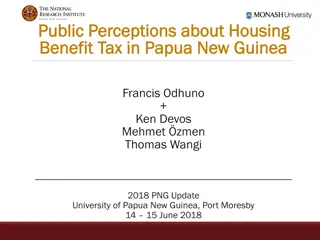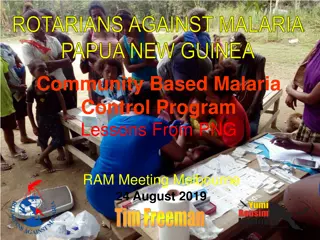Supporting Green Development in Papua New Guinea
Papua New Guinea (PNG) is a diverse tropical country with a significant intact area of tropical forest, facing challenges from drivers like commercial logging and agriculture. The country's REDD+ program aims to address these challenges and promote sustainable development.
Download Presentation

Please find below an Image/Link to download the presentation.
The content on the website is provided AS IS for your information and personal use only. It may not be sold, licensed, or shared on other websites without obtaining consent from the author.If you encounter any issues during the download, it is possible that the publisher has removed the file from their server.
You are allowed to download the files provided on this website for personal or commercial use, subject to the condition that they are used lawfully. All files are the property of their respective owners.
The content on the website is provided AS IS for your information and personal use only. It may not be sold, licensed, or shared on other websites without obtaining consent from the author.
E N D
Presentation Transcript
Papua New Guinea REDD+ Supporting Green Development in Papua New Guinea Gwendoline Sissiou Director, REDD+ and Mitigation Climate Change and Development Authority COP23 Side Event
Introduction to Papua New Guinea Papua New Guinea (PNG) is a tropical country and comprises the eastern half of the island of New Guinea in the South-West Pacific and includes 600 smaller islands; The country is very divers in landscapes, terrestrial and aquatic habitats, flora and fauna. The cultural diversity is equally large with probably over 800 different languages. Over 85% of the nation s 7.3m population are based in rural areas and rely primarily on subsistence agriculture; High levels of customary land ownership (over 97% of the country s land area) which is a major development challenge in the country;
Introduction to Papua New Guinea PNG has a significant intact area of tropical forest covering 77.8% of the country s 46.9m ha of land. Together with the forest of West Papua (Island of New Guinea) they represent one of the largest areas of intact tropical forest in the world; PNG s forests are also highly diverse, including 12 distinct forest types, with carbon-rich lowland tropical forest constituting over 50% of forest area; Main Drivers: Commercial Logging, Subsistence Agriculture and Commercial Agriculture
Important Note Future Drivers Population growth and changing national and international economies will causes changes in drivers Population increasing by 3% - over 9mill by 2020, 13mill by 2030 will create increasing pressure on resources Family farming including collection of fuel wood Commercial agricultural expansion will also be relevant with Increasing demand for development and international demand for agricultural commodities
Overview of the REDD+ Programme/PNG CCMA approved Start of FCPF Project Submission of FRL to UNFCCC NRS Endorsement Start of UN- REDD National Programme in PNG OCCES Establishment 2017 2008 2015 2011 2010 2014 2016 FRL and CE Passing of StaRS CEPA Act Climate Compatible Development Management Policy approved OCCD established Climate Compatible Development Strategy Launch of NFI Transition from OCCD to CCDA
Overview of the REDD+ Programme/PNG NRS developed and approved by NEC National REDD+ Strategy Forest Reference Level (FRL) FRL submitted and close to final National Forest Monitoring System (NFMS) NFMS developed http://png-nfms.org Terra PNG and Collect Earth Labs Safeguards Information System (SIS) Assessment of domestic safeguards completed
REDD+ and the NDC The GoPNG, through its StaRS has committed PNG to a low carbon green growth pathway, in line with the targets of Vision 2050 and the Development Strategic Plan 2010-2030. As per StaRs and Vision 2050 PNG has a target to reduce 50% of GHG emissions by 2030 and reach a point of carbon neutrality by 2050. PNG NDC s lays out a set of actions for addressing GHG emissions across sectors but do not include specific actions within the forest and land use sector, only acknowledging its importance in PNG and the need to develop both accurate estimates of emissions and potential actions.
REDD+ in Green Development Strategy Integrated into the second Medium Term Development Plan (MTDP) 2016-17 A Pathway to a Responsible Sustainable Future which includes Forests and Biodiversity, Agriculture and Eco-tourism within its priority economic sectors based on their value as strategic assets.
REDD+ in Green Development Strategy National Planning Framework Mainstreaming of Responsible & Sustainable Development & Climate Change Part of PNG s national drive towards Responsible and Sustainable Development Vision 2050 Constitution and StaRS CCMA / Paris Agreement Act DSP 2030 Sits within broader response to CC Mitigation Opportunity through coordinated action and financing to contribute to: MTDP REDD+ Sector / Subnational Planning Sector and national development goals Climate Change adaptation and mitigation Adaptation
Results/Progress/Achievements Climate Compatible Development Action Plan and Policy National REDD+ Finance and Investment Plan Climate Change (Management) Act UN Paris Agreement (Implementation) Act Initiation of access to GCF Finance both on CC Adaptation and Mitigation National REDD+ Strategy for 2017-2027
Key Lessons Cross-sectoral coordination and high level Buy-In towards development of RFIP to build stronger ownership and continued commitment of the leading government agencies REDD+ alignment with sectoral legislation and action plans National REDD+ Strategy Forest Reference Level (FRL) Stakeholders engagement at subnational level on REDD+ discussions, capacity building and awareness raising There has to be a better engagement with the private sector as it is a major contributor to the economy; National Forest Monitoring System (NFMS) Consider merging the GIS/Remote Sensing laboratories seeking financial sustainability and continue inter-agency dialogue on refining modalities for data sharing, privacy and use policies. Safeguards Information System (SIS) National Guidelines on FPIC and GRM is followed during the development of RFIP
Thank You Ms. Gwendoline Sissou Director, REDD+ and Mitigation Climate Change and Development Authority http://www.pngreddplus.org.pg/
